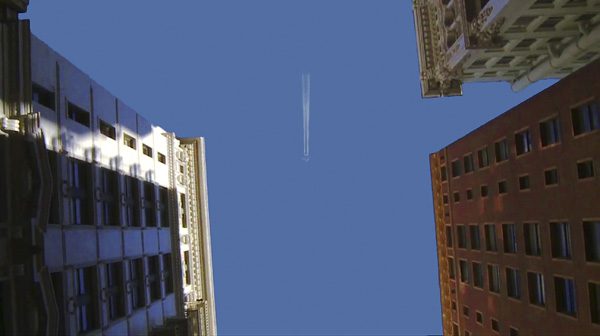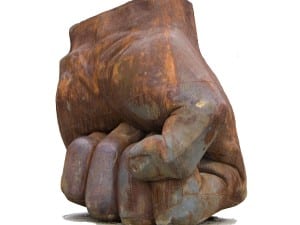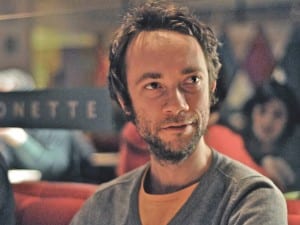Kevin Cooley presents his stunning photographs from his Night for Night series in Aesthetica Issue 51. His largescale video installation, Skyward, is currently on show at Pierogi’s The Boiler. Filmed in Los Angeles, the video examines the relationship between the natural world with the and manufactured landscape. The video takes the point of view of a passenger gazing upward through an open-top convertible, or sunroof while riding throughout the city. This point of view is then replicated in the gallery as the video is projected on an oversized, suspended screen, forcing the viewers to look up towards the skylight-tableau. We spend some time speaking to Cooley about how he produced Skyward and his plans for the future.
A: You work with photography and video art, is your video work an extension of your photography work or an artistic outlet in itself?
KC: I have worked with photography for a long time now, and it indeed informs all of my other work. Photography has given me a solid visual foundation to build from and my other work is definitely an extension of it. Yet, at this point I believe my video and installation projects express my concerns with a more dynamic vocabulary.
A: Skyward is a large video installation portraying Los Angeles’ manufactured landscape and its complex relationship to the natural world, does the interaction between the man made world and nature interest you?
KC: Much of my work for the past eight or nine years has revolved around this relationship, and Skyward uses the environs of Los Angeles as a starting point to talk about the intersection and overlap of these two worlds. In particular, I am interested in our collective obsession with conquering, overpowering, and controlling nature, yet there is still both a longing and a fear towards nature. We are constantly reminded that despite our best efforts, it is nature that is ultimately in control. Los Angeles is a superlative manifestation of this duality – an infrastructural city with a complex network of overlapping ecologies that is constantly in the midst of chaos.
A: What is it that draws you to pick up your camera and take a photo?
KC: There was a time when I would just go out for the whole day to shoot, forcing myself to make work, every when I didn’t want to. While it was a very disciplined way to work, it didn’t exactly yield the best imagery. These days when I pick up a camera it is for the express purpose of photographing something already planned in advance. I feel that I do a better job looking at the world without trying to looking through a view finder at the same time. I only using the camera as a tool once I know exactly what it is I want to photograph. It’s a means for me to reflect upon my view of the world in a carefully crafted and precise manner.
A: Is there anywhere in the world you’d like to work that you’ve not been able to yet?
KC: Absolutely, there are several places I would like to go. For starters I would like to continue to work on my “take refuge” project in Antarctica. I also would like to make a video piece at Lake Retba, in Senegal, which is an extraordinary shade of pink due to its high saline content. I’ve been inserting fluorescent pink elements in my video projects as a surrogate for “unnatural” human presence. Using pink found in nature would be an interesting play on this concept.
A: How do you want viewers to respond to your work, in particular Skyward?
KC: I believe my work exists on two levels. there is an immediate, carefully crafted, visual element that initially demands your attention. But there is also a much more complex set of concerns that I want people to consider after viewing the work. In other words, I want the work to be a starting place of a discussion, something that all artists must want to a certain extent. In the case of Skyward, I think it’s very important that the viewer become enveloped in the viewing experience, which is why I present it on the ceiling with cushions for people to lie on while watching.. The screen parallel to the ceiling becomes a trompe l’oeil, like a large skylight penetrating the darkness of the space. I hope that the viewers will think about how Skyward transcends the raw industrial space of The Boiler with the ethereal nature of the sky.
A: How did you go about producing Skyward?
KC: I began shooting migrating birds while driving across the US, a couple years ago. It was fall, and, I remember that in particular in South Dakota, there was an enormous flock of sparrows whose movements seemed choreographed and inspired. By the time I arrived in Los Angeles, I had become quite attuned to looking up while I was driving. In the coastal Mediterranean climate there, the sky, particularly in autumn, can be almost unnervingly blue. It struck me that disparate footage of the sky could be combined together, with the blue sky becoming the blue screen that filmmakers often build for special effects. LA’s crystallize skies often seem to represent opportunity or even paradise for some people, while others think of its problems with smog and air quality. I am fascinated by these contrasts, but I realized that I wanted to make a piece about the utopic promises upon which this 20th Century city was constructed. Using the car, and driving, as an allegorical device, I worked to encapsulate this idea of an entire world going on above us, often without our truly paying any attention to it. I spent the next four months shooting as much as I could around LA, both static shots and shooting through the sunroof of a moving car, before going back to New York. Then I spent the next six months putting this footage together to create a narrative.
A: What work have you got coming up in the future?
KC: I will be having my first museum show, at the Museum of Photographic Arts in San Diego this coming fall. I will be showing Skyward and Tow, a two channel video of an iceberg towed by a pink rope through the Arctic Ocean. Concurrent to the museum show, I will also have a solo exhibition at the Kopeikin Gallery in Los Angeles. I am thinking of showing a three channel video piece about an experience I had in Mongolia. We managed to get our 4×4 stuck in a bog in a remote, dead-end valley, about 100 miles from the nearest town. The video is about our failed attempts to get the jeep out of the bog. This is again another piece where you have this intersection of humanity vs. nature. I am also just starting a series of photographs in the mountains near LA that I am thinking of including in the show as well. Meanwhile, I am gearing up for a three month long residency at The Bemis Foundation in Omaha, Nebraska, and I plan to work on a large installation project there. I’m thinking of doing a project about the sun, but I’m not sure exactly how it might take shape just yet.
A: Are there any other artists at work at the moment that you’d like to collaborate with?
KC: A few years ago I was asked to be in a show that paired artists with writers to make a series of collaborative works. The curator wanted to me to work with Rebecca Solnit and I was very excited about the prospect of doing so. The show did not end up happening but I still quite like the idea of working on a project with her. I feel like we often are speaking about similar concerns in our work.
Kevin Cooley: Skyward, Until March, The Boiler, 191 North 14th Street Brooklyn, NY 11211.
Skyward installation images courtesy of Pierogi Gallery, Skyward video stills courtesy of artist, Pierogi Gallery, Brooklyn and Kopeikin Gallery, Los Angeles.





